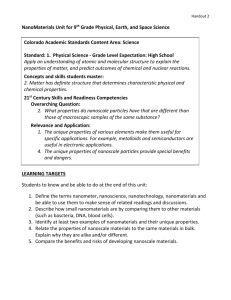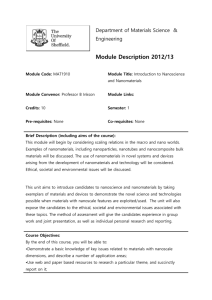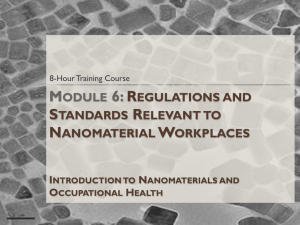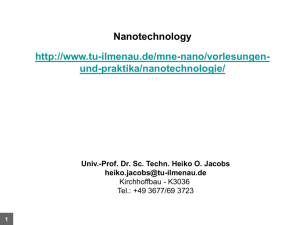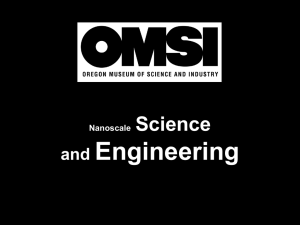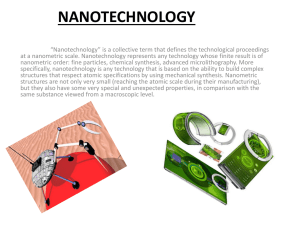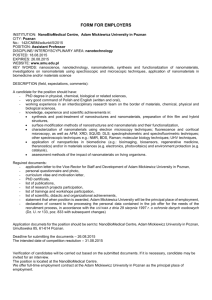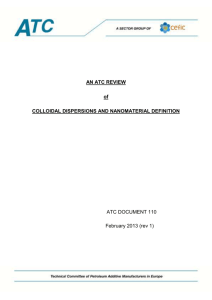Introduction to Nanomaterials and Occupational Health
advertisement
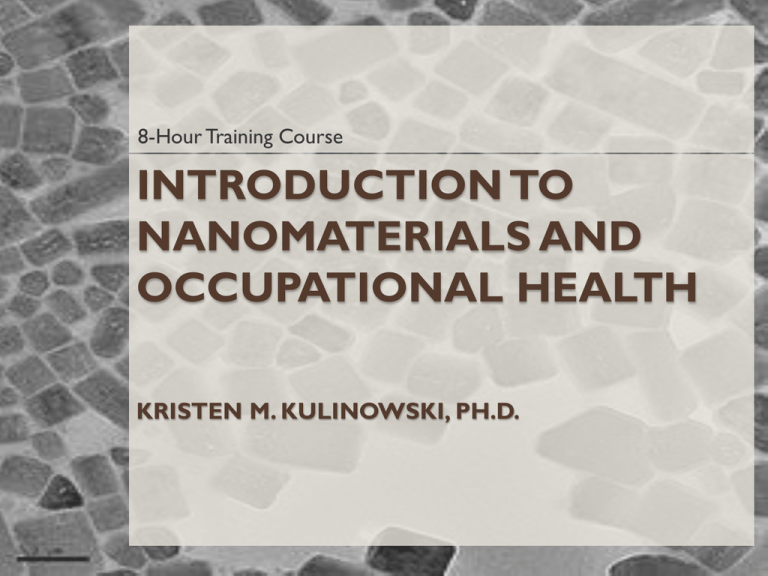
8-Hour Training Course INTRODUCTION TO NANOMATERIALS AND OCCUPATIONAL HEALTH KRISTEN M. KULINOWSKI, PH.D. This material was produced under grant number SH-21008-10-60-F-48 from the Occupational Safety and Health Administration, U.S. Department of Labor. It does not necessarily reflect the views or policies of the U.S. Department of Labor, nor does mention of trade names, commercial products, or organizations imply endorsement by the U.S. Government. 1-2 Eight-Hour Training Course Module 1 Introduction to Nanotechnology and Nanomaterials Module 2 What Workers Need to Know about Nanomaterial Toxicology Module 3 Assessing Exposure to Nanomaterials in the Workplace Module 4 Controlling Exposure to Nanomaterials BREAK Module 5 Risk Management Approaches for Nanomaterial Workplaces Module 6 Regulations and Standards Relevant to Nanomaterial Workplaces Module 7 Tools and Resources for Further Study 1-3 Lesson Overview Purpose To provide workers with introductory information about nanotechnology and nanomaterials Topics 1. How small is a nanometer? 2. Definitions and commonly used terms 3. How is the nanoscale different from the macroscale or the atomic scale? 4. Major classes of nanomaterials and their benefits 1-4 Learning Objectives At the end of this module you should be able to Contrast objects at the nanoscale with larger and smaller forms of matter Define key terms in nanotechnology Explain some of the ways nanomaterial properties differ from molecules and microscale particles Describe some of the physical and chemical characteristics that can change at the nanoscale Describe some of the major classes of nanomaterials produced today and their properties and potential benefits 1-5 Topic 1 HOW SMALL IS A NANOMETER? Topic 1: How small is a nanometer? 1 nm = 0.000000001 m = 10-9 m = one billionth meter http://www.sniffcode.com/view.php?id=8 1-7 Handout 1 VIRUS Courtesy Office of Basic Energy Sciences, Office of Science, U.S. DOE 1-8 Where does each of these fit? Place the following objects on the ruler according to their approximate size. (Use diameter unless otherwise specified.) 1. 2. 3. 4. Bacterium Ant Molecule Buckyball (C60) 5. 6. 7. Virus Human hair Atom 1-9 Topic 2 DEFINITIONS AND COMMONLY USED TERMS Topic 2: Definitions and Commonly Used Terms Key terms: nanotechnology, nanoscale, nanomaterial, nanoparticle, nanofiber There are several standard definitions for each of these GROUP ACTIVITY (See Handout 2) In groups of 3-5, find similarities and differences among the definitions of nanotechnology, nanoparticle and nanomaterial published by ASTM, BSI and OSHA. 1-11 Flowchart for Nanotechnology Terms 1-12 What is it? Nanofiber OR Nanomaterial 1.5 nm x 1.5 nm x 10 m Nanoparticle OR Nanomaterial 60 nm diameter (57 nm core: 3 nm shell) Nanostructured material Large voids: >200 nm diameter Small inner pores: ~60 nm diameter 1-13 Different Types of Nanomaterials Naturally Occurring Human Origin (Incidental) Human Origin (Engineered) Forest fires Cooking smoke Metals Sea spray Diesel exhaust Quantum dots Mineral composites Welding fumes Buckyballs/Nanotubes Volcanic ash Industrial effluents Sunscreen pigments Viruses Sandblasting Nanocapsules Nanotechnology 1-14 Topic 3 HOW IS THE NANOSCALE DIFFERENT FROM THE MACROSCALE OR THE ATOMIC SCALE? Topic 3: How is the nanoscale different from the macroscale or the atomic scale? Baseball: ~2.8 inches in diameter Softball: ~3.8 inches in diameter 1-16 Nanomaterial Properties Can Change with Size Classical Mechanics (Everyday Physics) Quantum Mechanics (Wave Physics) 0.1 1 10 100 1000 Length Scale (nm) The nanoworld At the nanometer scale, fundamental physical and chemical properties depend on the size of the object. 1-17 Early Nanotechnologists Lycurgus Cup http://www.britishmuseum.org/explore/highlights/highlight_objects/pe_mla/t/the_lycurgus_cup.aspx 1-18 Would you buy this gold? Gold (~ 10 nm) Bulk Gold (Au) = Yellow Conductive Nonmagnetic Chemically inert Nano Gold = Red Loses conductivity at ~ 1-3 nm Becomes magnetic ~ 3 nm Explosive and catalytic! 1-19 Physical and Chemical Properties that can Change at the Nanoscale Color Melting temperature Crystal structure Chemical reactivity Electrical conductivity Magnetism Mechanical strength … 1-20 Nanomaterials Exhibit Diversity in… Chemical composition Form or shape Surface treatments 1-22 1m ¼m Surface Area is a Big Factor GOLD Each side =1 m Mass ≈ 43,000 lb Surface Area (SA) = 6 m2 ≈ 8 ft x 8 ft room Each side =1/4 m Mass ≈ 43,000 lb SA = 24 m2 Each side =1 nm Mass ≈ 43,000 lb SA = 6 billion m2 ≈ 2500 miles2 State of Delaware = 2490 miles2 1-23 Topic 4 MAJOR CLASSES OF NANOMATERIALS AND THEIR BENEFITS Major Classes of Nanomaterials and Sample Applications Category Chemical Composition Product example Fullerenes, Nanotubes; Nanowires carbon, boron nitrides Anti-static fabrics Metals silver, gold, iron, copper Anti-microbial wound dressings Ceramics (metal oxides) titanium dioxide, zinc oxide, Sunscreen filters, selfcerium oxide cleaning glass Semiconductors (Quantum dots) cadmium selenide, cadmium telluride Medical imaging agents Polymeric hydrocarbon polymers Drug delivery devices 1-25 Detecting Cancer Cells What is it? Small SiO2 (silica) sphere with thin gold coating Advantages Enhances the detection of cancer cells in real without nanoshells time Why Nano? with Particle size affects its nanoshells response to light Breast Cancer Res Treat (2010) 120:547–555 without nanoshells normal HER2cancer with nanoshells HER2+ cancer 1-26 Self-Cleaning Glass What is it? Thin film of titanium dioxide bonded to glass Advantages Reduces energy Self-cleaning glass usage PPG Industries Reduces cost and effort of cleaning glass Why Nano? Film doesn’t change glass color Nano-size enhances the photocatalytic effect 1-27 Small Change, Big Savings What is it? Thin film of polymer bonded to paint Advantages Reduces friction-causing debris build-up on plane surface Reduces fuel consumption 1-2% ~$22 million Why Nano? Film adds a mere 4 oz to weight of the jet (compared to 176 pounds of paint) 1-28 Balancing the Benefits and Risks Nanomaterials’ special physical and chemical properties may lead to unexpected interactions with biological and environmental systems. 1-29 Eight-Hour Training Course Module 1 Introduction to Nanotechnology and Nanomaterials Module 2 What Workers Need to Know about Nanomaterial Toxicology Module 3 Assessing Exposure to Nanomaterials in the Workplace Module 4 Controlling Exposure to Nanomaterials LUNCH (on your own) Module 5 Risk Management Approaches for Nanomaterial Workplaces Module 6 Regulations and Standards Relevant to Nanomaterial Workplaces Module 7 Tools and Resources for Further Study 1-30 Learning Objectives At the end of this module you should be able to Contrast objects at the nanoscale with larger and smaller forms of matter Define key terms in nanotechnology Explain some of the ways nanomaterial properties differ from molecules and microscale particles Describe some of the physical and chemical characteristics that can change at the nanoscale Describe some of the major classes of nanomaterials produced today and their properties and potential benefits 1-31
